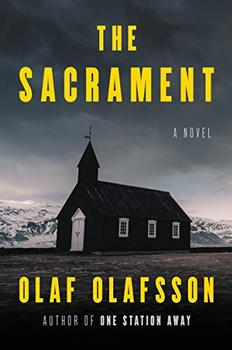Summary | Excerpt | Reading Guide | Reviews | Beyond the book | Read-Alikes | Genres & Themes | Author Bio

Hannah Kent's novel Burial Rites is as dark and cunning as the recurrent ravens in her exceptional debut. Based on real events, the novel recounts the story of Agnes Magnúsdóttir, an Icelandic workmaid charged with murder in 1828.
Born in Adelaide, Australia, in 1985, the author was a teenager when she traveled to Iceland and first heard Agnes's story. Kent's fictional interpretation is informed by years of research, including interviews with Icelanders, ministerial records, parish archives, censuses, local histories and publications.
In the novel's opening chapters, Agnes's sentence—beheading—is revealed. While she awaits execution she is moved from a holding with brutal, deplorable conditions to a farm called Kornsá. Using one of her few remaining rights, she requests as her spiritual advisor a young assistant reverend named Tóti.
At first, Agnes is feared and shunned by the family she joins at Kornsá: a district officer who is duty-bound to house her, as well as his wife Margrét and their two daughters, Steina and Lauga. Even the reverend is horrified in Agnes's presence and describes the seemingly doomed 33-year-old "like a new corpse, fresh dug from the grave." Early on, Tóti admits to Agnes that his training is incomplete. Secretly he agonizes about what kind of reverend he will be if he can't stand the sight of suffering.
During one of his visits to the Kornsá farm, Margrét confides in Tóti her resentment about sheltering Agnes (one of the Devil's children, she says), then focuses her attention on a small flock of ravens flying over a nearby mountain range. Citing traditional belief, Margrét asserts the correct name for a flock of ravens is a conspiracy. Yet the reverend says, "I thought they were called an unkindness." Later, as Margrét starts to soften toward the prisoner in her house, we discover that a conspiracy of sorts may apply to Agnes, as well, and the circumstances surrounding her impending fate.
While unkindness abounds in this richly plotted story, small yet significant good deeds also prevail. Tóti, for instance, is chosen by Agnes, not for the purpose of absolution but because he once helped her over a flooded river, a fleeting occurrence he had forgotten. And Steina, the eldest of the two daughters at Kornsá, remembers when she and her sister were children they had a brief, but impressionable, encounter with Agnes.
Despite Agnes's growing reservations about Tóti's youth ("They condemn me to death and I ask for a boy to coach me for it"), along with his own increasing doubts about saving her soul, he perseveres, hoping he may gain Agnes's trust and she will finally atone. Instead, as she reveals details from her past, she unnerves the earnest but naïve reverend with her cleverness and wariness, her insight about the ways of the world that still elude him. In one scene she says, "To know what a person has done, and to know who a person is, are very different things."
Through a varied narrative that includes multiple perspectives, letters and haunting poems, Kent's novel unravels with superb pacing and suspense, eventually revealing the truth of what happened the winter night two men were murdered at Illugastadir, a farm by the sea. Chapters employing Agnes's direct voice are especially powerful. Determined to close herself to the world and those who have condemned her, she thinks, "They will see the whore, the madwoman, the murderess, the female dripping blood into the grass and laughing with her mouth choked with dirt...They might see the lamb circled by ravens, bleating for a lost mother. But they will not see me. I will not be there."
Kent also keenly captures the uniqueness of her novel's setting: Iceland's beauty and isolation, its sense of solitude—and despair. Remembering Illugastadir, Agnes says to Toti, "The shore is of pebbles, and huge tangles of seaweed float in the bay and look like the hair of the drowned." Threaded throughout the novel are other striking (and frightening) images: "blizzards that howl like the widows of fishermen," shrieking seagulls, and a two-headed lamb.
In her author's note, Kent explains that after reading publications that were particularly contemptuous of Agnes's character, she wanted to supply a more ambiguous portrayal. What defies equivocation, however, is Kent's riveting account that imaginatively and thoughtfully explores who Agnes was, and what she did, resulting in a story as wrenching as it is emotionally chilling.
![]() This review was originally published in The BookBrowse Review in September 2013, and has been updated for the
April 2014 edition.
Click here to go to this issue.
This review was originally published in The BookBrowse Review in September 2013, and has been updated for the
April 2014 edition.
Click here to go to this issue.

If you liked Burial Rites, try these:

by Kiran Millwood Hargrave
Published 2021
After the men in an Arctic Norwegian town are wiped out, the women must survive a sinister threat in this "perfectly told" 1600s parable of "a world gone mad" (Adriana Trigiani).

by Olaf Olafsson
Published 2020
The haunting, vivid story of a nun whose past returns to her in unexpected ways, all while investigating a mysterious death and a series of harrowing abuse claims.
Your guide toexceptional books
BookBrowse seeks out and recommends the best in contemporary fiction and nonfiction—books that not only engage and entertain but also deepen our understanding of ourselves and the world around us.